Emphasis on Grades (Thermoforming, Injection Molding, Extrusion, Blow Molding, and Others); End-User (Packaging, Consumer Goods, Agricultural, Textile, Medical, and Others); and Region and Country
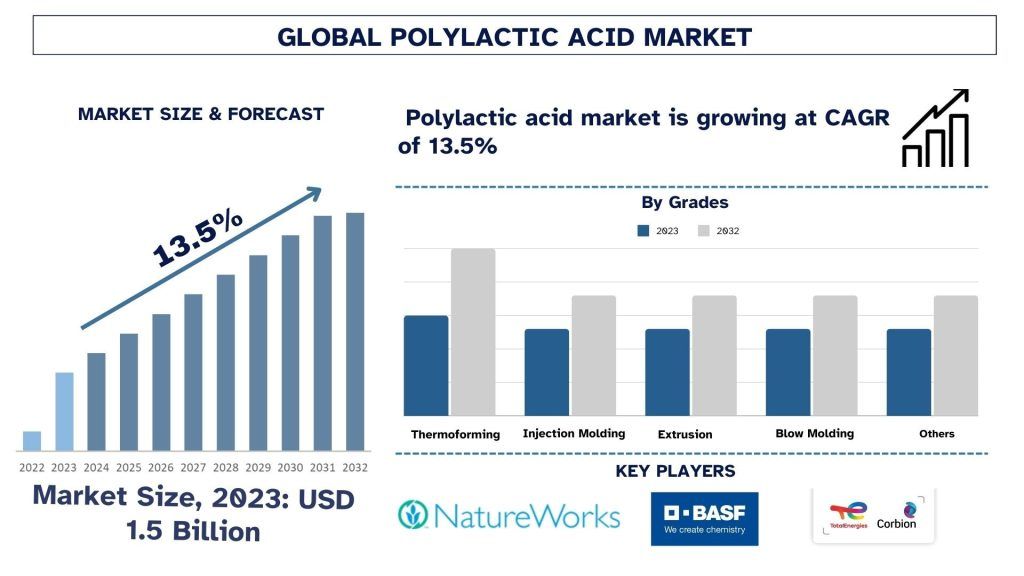
The Polylactic Acid market was valued at approximately USD 1.5 Billion in 2023 and is expected to grow at a robust CAGR of around 13.5% during the forecast period (2024-2032). Global demand for polylactic acid or PLA is on the rise due to efficiency in its application, the promotion of environmentally friendly projects, and the advancement of eco-friendly packaging.
The rapid increase in demand owing to population growth and higher incomes coupled with their lightweight, inexpensive, readily processable, and durable properties. In addition, during the same period, plastic waste generation has increased by 197 Mt surpassing the growth of plastic production. Further, it is expected that the amount of plastic waste will increase to 850 Mt per annum by 2050. As a result, increasing concern among environmental bodies to control plastic waste generation. This, in turn, promotes the use of recycling or biodegradable plastics. Polylactic acid is one of the most widely consumed bioplastics and has similar characteristics to polypropylene (PP), polyethylene (PE), or polystyrene (PS), as well as being biodegradable. The material properties of PLA make it suitable for the manufacture of plastic film, bottles, and biodegradable medical devices, including screws, pins, plates, and rods that are designed to biodegrade within 6 to 12 months. Therefore, it is expected that as the world is moving rapidly toward sustainable alternatives, the demand for polylactic acid is likely to showcase bolstering growth during the foreseeable future.
This section discusses the key market trends influencing the fungicide segments as identified by our research experts.
Thermoforming Segment Transforming Industry
Based on grades, the market is categorized into thermoforming, injection molding, extrusion, blow molding, and others. Among these, thermoforming accounted for a significant share of the market and is likely to maintain a strong position during the forecast period. This can be attributed to its fully compostable and degradable properties coupled with similar properties to several conventional petrochemical-based resins. As a result, it is used in many application areas like food & beverage packaging.
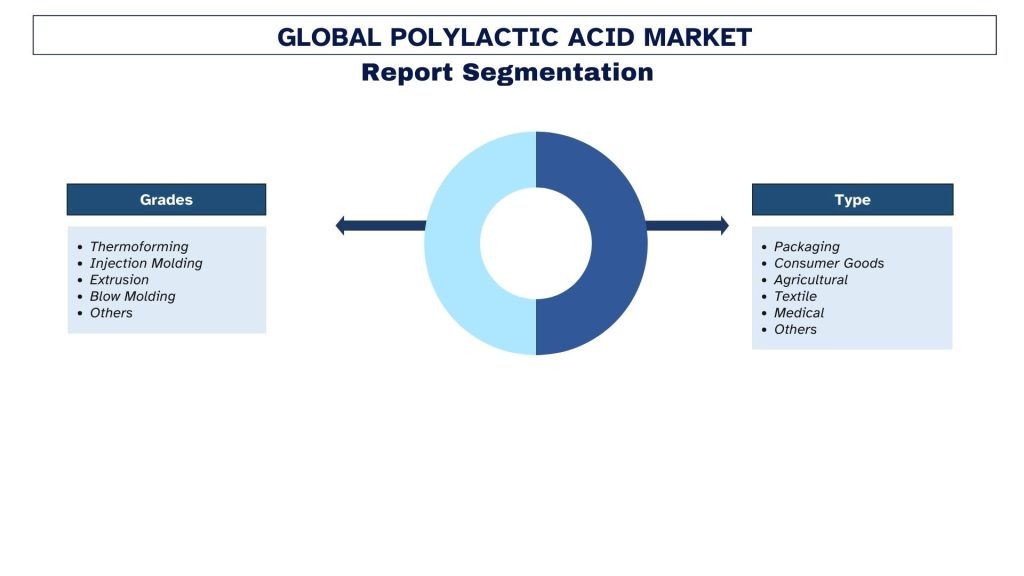
Asia-Pacific accounted for a significant share of the market
Asia-Pacific is expected to showcase significant growth over the forecast period owing to the growing end-use industry, increasing regulation on reducing the use of non-degradable plastics, and rising adoption of sustainable packaging solutions among consumers.
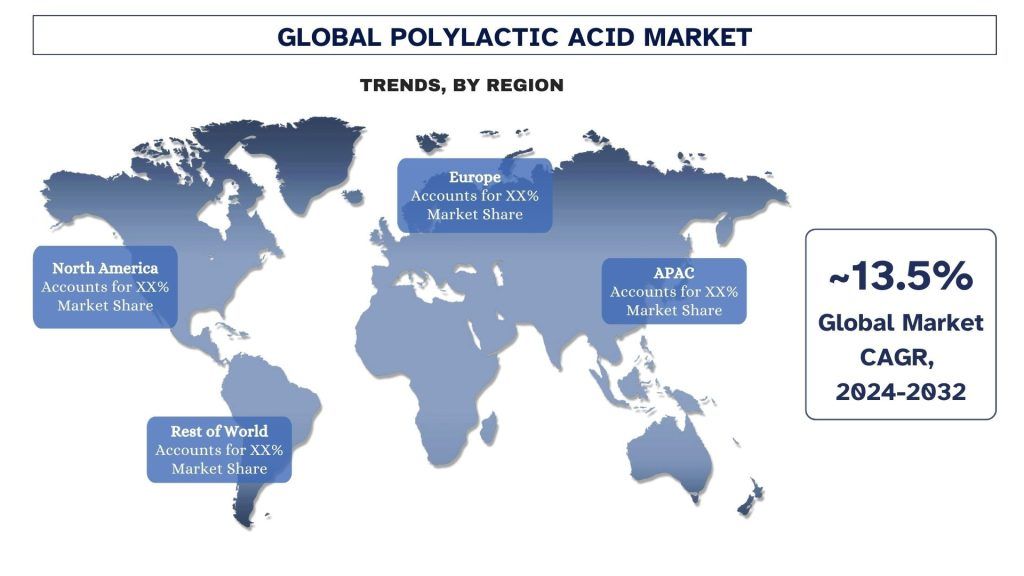
Polylactic Acid is competitive, with several global and international market players. The key players are adopting different growth strategies to enhance their market presence, such as partnerships, agreements, collaborations, new product launches, geographical expansions, and mergers and acquisitions. Some of the major players operating in the market are NatureWorks LLC, BASF, TotalEnergies Corbion, Futerro, COFCO Group, Mitsubishi Chemical Group Corporation, Danimer Scientific, UNITIKA LTD, Evonik Industries AG, TORAY INDUSTRIES, INC. Several M&As along with partnerships have been undertaken by these players to facilitate customers with hi-tech and innovative products/technologies.
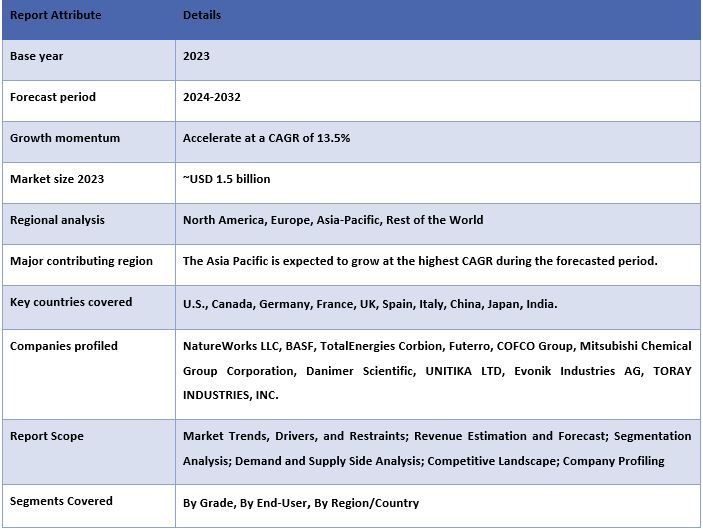
Reasons to buy this report:
Customization Options:
Global Polylactic Acid can further be customized as per the requirement or any other market segment. Besides this, UMI understands that you may have your own business needs; hence, feel free to connect with us to get a report that completely suits your requirements.
1. Market Introduction
2. Research Methodology Or Assumption
3. Executive Summary
4. Market Dynamics
5. Pricing Analysis
6. Global Polylactic Acid Market Revenue (usd Bn), 2022-2032f
7. Market Insights By Grades
8. Market Insights By End-user
9. Market Insights By Region
10. Value Chain Analysis
11. Competitive Landscape
12. Company Profiled
13. Acronyms & Assumption
14. Annexure
Analyzing the historical market, estimating the current market, and forecasting the future market of the global Polylactic Acid market were the three major steps undertaken to create and analyze the adoption of Polylactic Acid in major regions globally. Exhaustive secondary research was conducted to collect the historical market numbers and estimate the current market size. Secondly, numerous findings and assumptions were taken into consideration to validate these insights. Moreover, exhaustive primary interviews were also conducted, with industry experts across the value chain of the global Polylactic Acid market. Post assumption and validation of market numbers through primary interviews, we employed a top-down/bottom-up approach to forecasting the complete market size. Thereafter, market breakdown and data triangulation methods were adopted to estimate and analyze the market size of segments and sub-segments of the industry. Detailed methodology is explained below:
Step 1: In-Depth Study of Secondary Sources:
A detailed secondary study was conducted to obtain the historical market size of the Polylactic Acid market through company internal sources such as annual reports & financial statements, performance presentations, press releases, etc., and external sources including journals, news & articles, government publications, competitor publications, sector reports, third-party database, and other credible publications.
Step 2: Market Segmentation:
After obtaining the historical market size of Polylactic Acid, we conducted a detailed secondary analysis to gather historical market insights and share for different segments & sub-segments for major regions. Major segments are included in the report, such as grades, end-user, and region. Further country-level analyses were conducted to evaluate the overall adoption of testing models in that region.
Step 3: Factor Analysis:
After acquiring the historical market size of different segments and sub-segments, we conducted a detailed factor analysis to estimate the current market size of the Polylactic Acid market. Further, we conducted factor analysis using dependent and independent variables such as grades, end-user, and Polylactic Acid regions. A thorough analysis was conducted of demand and supply-side scenarios considering top partnerships, mergers and acquisitions, business expansion, and product launches in the Polylactic Acid market sector across the globe.
Current Market Sizing: Based on actionable insights from the above three steps, we arrived at the current market size, key players in the global Polylactic Acid market, and market shares of the segments. All the required percentage shares split and market breakdowns were determined using the above-mentioned secondary approach and were verified through primary interviews.
Estimation & Forecasting: For market estimation and forecast, weights were assigned to different factors including drivers & trends, restraints, and opportunities available for the stakeholders. After analyzing these factors, relevant forecasting techniques i.e., the top-down/bottom-up approach were applied to arrive at the market forecast for 2032 for different segments and sub-segments across the major markets globally. The research methodology adopted to estimate the market size encompasses:
Primary Research: In-depth interviews were conducted with the Key Opinion Leaders (KOLs), including Top Level Executives (CXO/VPs, Sales Head, Marketing Head, Operational Head, Regional Head, Country Head, etc.) across major regions. Primary research findings were then summarized, and statistical analysis was performed to prove the stated hypothesis. Inputs from primary research were consolidated with secondary findings, hence turning information into actionable insights.
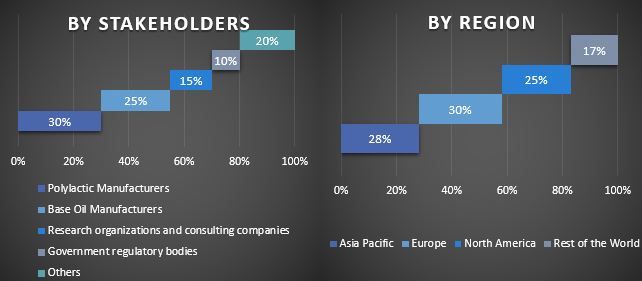
Market Engineering
The data triangulation technique was employed to complete the overall market estimation and to arrive at precise statistical numbers for each segment and sub-segment of the global Polylactic Acid. Data was split into several segments and sub-segments after studying various parameters and trends in the grades, end-users, and regions of the global Polylactic Acid market.
The current & future market trends of global Polylactic Acid were pinpointed in the study. Investors can gain strategic insights to base their discretion for investments on the qualitative and quantitative analysis performed in the study. Current and future market trends determined the overall attractiveness of the market at a regional level, providing a platform for the industrial participant to exploit the untapped market to benefit from a first-mover advantage. Other quantitative goals of the studies include:
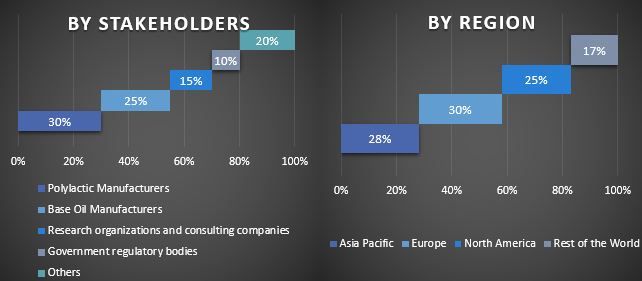
Q1: What are the global Polylactic Acid Market current size and growth potential?
Q2: What are the driving factors for the growth of global Polylactic Acid Market?
Q3: Which segment has the largest share of the global Polylactic Acid Market by grade?
Q4: What are the emerging technologies and trends in global Polylactic Acid Market?
Q5: Which region will dominate global Polylactic Acid Market?
Customers who bought this item also bought